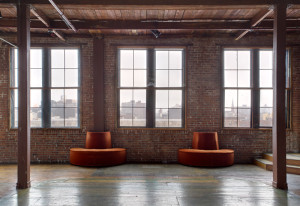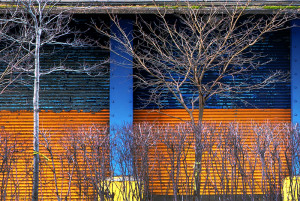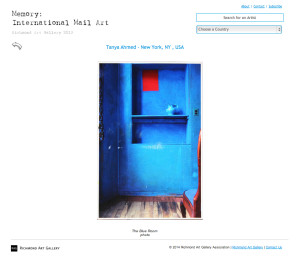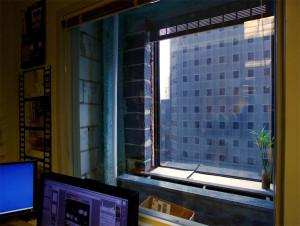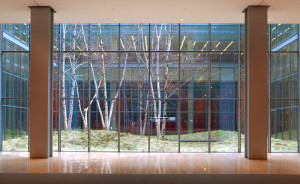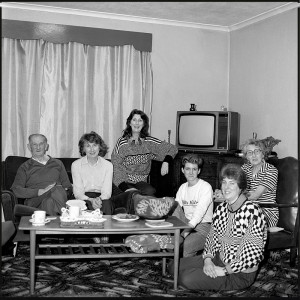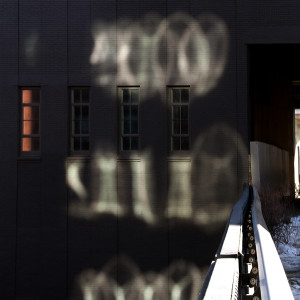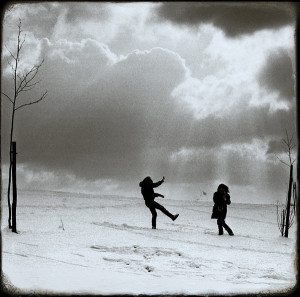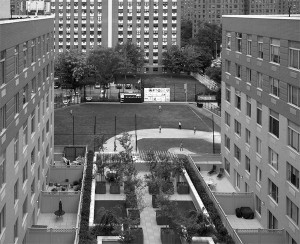Amazing loft space, but do those chairs strike anyone else as not belonging in the daylight? I feel like they have escaped from a disco!
2014
ˈfōtō ˈfôrtˌnīt frīdē
Richmond Art Gallery
Richmond Art Gallery Mail Art Exhibition and Swap.
http://richmondartgallery.org/internationalmailart2013/
1300 artworks were shown in this mail art exhibition that included 1 of my photographs. I didn’t see the exhibition as it was in Canada, but it is now online.
I discovered that my photograph was featured right under the headline of the show, you can see it, via the link, in situ, in the third photograph, under the show’s heading: Memory: International Mail Art Exhibition and Swap. It is so cool to be able to see all the other pieces and you can search by country or name to get a closer look. I wonder which one will be my swap.
Here’s my image as it appears if you search under my name, but click through to the website to see the installation photographs and search out other artists’ work.
fōtō ˈfôrtˌnīt frīdē
Things are not always as they seem.
I was in midtown, in a very fancy, modern office building, visiting an immaculate office, then I moved towards the window…
The window looked out revealing not only the view across 6th Avenue but also a space beyond the outer wall of the room which as it turned out was not the outer wall of the building. The area didn’t look quite finished to me. The odd area of ragged incompletion surprised me. It was cut off from the building’s occupants, beyond the window and yet someone somehow traversed that small space in order to put a plant on the unfinished window sill.
ˈfōtō ˈfôrtˌnīt frīdē
Terrarium
This is the lobby of the New York Times building in midtown. I always think these terrariums are an odd feature, we can see nature but we can’t touch it or be with it or even breathe the same air. Is it enough to just be teased by seeing nature in its closed box? Maybe we shouldn’t bother at all.
March, Redaction and my Oeuvre
March 08, 2014
I’ve been thinking about Archive lately and how I might explore it further
I’m very much a believer in serendipity and these thoughts coupled with an essay I am currently reading by A.D. Coleman that coincides with the month of March have set me to collating a set of work from my existing files.
The dictionary term archive is defined as a collection of historical documents or records providing information about a place, institution or group of people. Historical, of course, means belonging to the past.
Therefore any photographs I have taken constitute historical, as the time of recording them has passed. But what of the archive? Is it the same as my oeuvre or body of work?
In his essay, On Redaction. Heaps and Wholes, or, Who empties the Circular File, A.D. Coleman quotes the photographer Lonny Shavels who claims that “Photography is about editing. If you don’t edit your work you are not a photographer.” (Coleman, 2000)
Exploring the essay’s title, Coleman states that “The question of redaction of ‘putting in shape for publication’ is a crucial one. Redaction is what transforms a quantity of images from a heap to a whole.’ (Coleman, 2000)
Coleman summarizes that ‘these redacted segments constitute the whole of the photographer’s body of work; the rest – no matter how much it may attract us- is merely part of the heap.’ (Coleman, 2000)
If I am to put Coleman’s words into action I should go through my files and get them ready for (impending or hoped for) publication. Only then will they count as an officially sanctioned body of work.
So, to the heap!
I have previously, partially edited my files. My project Building Character came about from a systematic organization of twenty five years of work relating to my geographical and cultural assimilation of the built environment.
Now entering March, the month has inspired me to think of a new direction. In the USA, UK and Australia March is dedicated as Women’s History Month. March 8th, today, is International Women’s Day. A global day of recognition and celebration and an official holiday in a further 27 countries.
Although my website currently features many images of the physical structures of the built environment I have many unseen photographs of people.
Unfortunately over the years I have not taken photographs of many of the women I have met and spent time with. I am guilty of taking these women for granted. In effect aping what history has done, looking for the exceptional or unique rather than the backbone, the enduring support from where we all spring.
I still have enough though to make a project. But what of the men? Am I to exclude photographs that feature both men and women? That is surely as much discrimination as if I were not to include women. And what of the historical worth of the women I have photographed. None of them were the first to fly solo across the Atlantic, the first to hold elected office or founded modern nursing. I believe that all women touch the lives of hundreds if not thousands of people during their lifetimes and whilst exceptional women are inspiring, all women are exceptional in their own way. Each woman has her place in history and we should celebrate the worth of all of them. After all not one of us would be here without women.
So I have decided to rethink my approach and look to the photography rather than the gender as I sort through my images this is a project that won’t be resolved in March.
I still do want to celebrate women on this day though and remind myself that not all women have equal fortune in life. We should use this day to appreciate the women in our lives and their contribution to their communities before they are no longer with us and fade into history.
I have decided to choose just one photograph to celebrate International Women’s Day. The two criteria I used were the woman/women were inspiring and that their environment was also shown. So I chose the photograph below. A simple gathering at the family home with multiple generations present. The missing information that I will supply is that three of these women * touched thousands in their jobs as teachers, at schools and colleges. Passing on their knowledge empowered the children and young adults they met and many owe their success at school and into their work lives to the attention and education these women shared with them.
February 1990, Hutton Road.
L-R Ted: husband, father, grandfather. (deceased). Teddy*: daughter, sister, mother, aunt, (deceased). Marlene*: daughter, sister, mother, aunt. (deceased). T: daughter, grand-daughter, cousin, niece. L: daughter, grand-daughter, cousin, niece. Constance*: wife, mother, grandmother. (deceased).
Reference List
Coleman, A.D., 2000, Depth of Field, Essays on Photography, Mass Media and Lens Culture, University of New Mexico Press, Albuquerque
ˈfōtō ˈfôrtˌnīt frīdē
ˈfōtō ˈfôrtˌnīt frīdē
Snow is an ugly thing in New York City. A few hours after the first pristine fall of the year the joy is over. Head high grey mountains are assembled by ploughs. Simultaneously deep, wide, lakes of slush collect at corners that resemble mountain passes. Anyone who wants dry feet must leap 4-6 feet if they want to get off their block. At night the whole mess freezes over and this winter, by morning, the snow inevitably has started up again.
But this is New York and the weather can turn quickly. A few hours after the slog of the morning snowy/wet/icy commute, there was a beautiful clear blue sky and sunshine. Warm enough to take off the hats and gloves AND unbutton the jacket. For a few minutes I forgot how filthy, untidy and annoying the city is when it is blanketed with snow. It made me think of this image from my archives from a time when I perceived snow as clean and fun!
I came across these kids whilst I was driving. I slammed on the brakes, threw the car up off the road and jumped out, trying to capture the sun’s rays that were highlighting the girls as they threw snowballs at each other. It was a beautiful scene, uplifting in the simple game of the girls, the magnificence of the sunbeams breaking through the heavy clouds and the sheer fun of leaping out of the car and rushing up the snowbank to capture the scene.
I’ll try to remember these positive emotions for the next snowfall, which according to the weather report will be, unsurprisingly, tomorrow!
ˈfōtō ˈfôrtˌnīt frīdē
TGIF – I have been waiting all week to introduce a website to you.
Run by London photographers Peter Marshall and Mike Seaborne, their Urban Landscape site is dedicated to some fascinating photography. Exploring both images and theory they ‘intend to feature the best in photography and critical writing on the urban landscape from around the world.’
The site features great swathes of Mike and Peter’s own in-depth projects on London, and also a variety of projects from invited contributors with links for further exploration. Feeling honoured, it gives me great pleasure to let you know that I have been invited to share their platform.
For my submission I decided to rework my East 100th Street project and produce a series that contextualizes East 100th Street within its East Harlem, New York City locale.
I am introducing 10 images that have not been seen before to add to another 10 from East 100th Street project and 20 from my Building Character project. I have also written a bit of a blurb, an introduction and 2 project descriptions, that aim to give some insight into my thoughts behind these projects.
Here’s one more new image to get you started…
… and here’s that link again…
I hope that you enjoy exploring the urban landscape.
In the news today
In the news today…
Today I reacted quite strongly to a photograph from AFP on the BBC news website.
The article is about Egypt and if you scroll down to the picture of the children I wonder if you’ll see what I see.
Someone, presumably the parent of the children, has encouraged the children to stand, in support of army rule, by symbolically holding army boots on their heads.
http://www.bbc.co.uk/news/world-middle-east-25924027
It immediately sent a cultural reference through my mind,
Under the jackboot.
Dictionary definitions for jack boot include: (1) A person who uses bullying tactics, especially to force compliance. (2) The spirit sustaining and motivating a militaristic, highly aggressive, or totalitarian regime or system.
As it turns out several people I asked were not familiar with this phrase. Which led me to wonder about the message this image portrays.
My initial impression from the photograph alone was that these children were expressing their oppression by the army. However, the photograph was accompanied by a caption that said that the children were showing their support for the army.
Hmmm… I still couldn’t see it. How could being stomped on by the army lead to a fulfillment of the rallying cry of the January 25th revolution in 2011- Bread, Freedom and Dignity?
Obviously I was inserting my own cultural reading. I sought out the Egyptian view.
The people I spoke with also found the image very disturbing. There is a division in Egypt at the moment, those for and those against the army. Those against the army have called their opponents, the army supporters ‘slave of the shoes’.
In reaction the supporters of the army, such as the girls pictured, are acting out an Arabic saying را جزمتك علي راسي ( transliteration: ghazmitack ala rhasi) that translates to ‘Your shoes on top of my head.’
Basically what this means is that they are showing loyalty to the army, showing gratitude and respect by putting the army (symbolized by the boots) on their head (as opposed to at their feet) and themselves consequently as low as they can go, ie under the boot, level with the ground. Not slaves but willingly level with the actual ground supporting the army.
Still I can’t get how this is a positive statement by putting yourself lower than a boot, literally underfoot, where is the self respect? It gets worse because apparently the idea that you would put a filthy shoe on your head, even an ordinary one, is culturally disrespectful and far from being seen as a way to show appreciation the phrase جزمتك علي راسي is seen as denigrating to the utterer.
I can’t untangle the psyche of this action but I can think about the photograph and its power. This photograph speaks clearly to me but not in the way it was intended, or does it? Is the photographer for or against the army? Does the photographer know about جزمتك علي راسي Is the photographer Egyptian or foreign? Posting this image to show support or opposition? Does this image prove how upside down things are in Egypt? Does this image show solid support for the army or a populace ground down with nowhere else to turn? I won’t even venture into talking about the children and their future, just to say what a very sad picture this in on so many levels.
UPDATED: I left this post but feel I have to come back to that photo again. Not being able to see the tops of the boots it could almost be that a soldier is standing on the heads of these young girls. Demure and innocent, not smiling or shouting, just quietly supporting, wrapped in the flag of Egypt- They are everything pure and submissive that the Field Marshall, the sunglasses hero posed in front of a lion… that natural animal of Egypt, not, needs to gain control. Passivity, and adoration. Not pesky protesting types who want an open democracy or religious types who might object to hero worship. No, adore the Lion of Egypt, cool and manly, c’mon ladies grow up with me as your leader you know that is what counts, that I can succeed on your compliance.
OK that’s it.
Any thoughts on this image?








